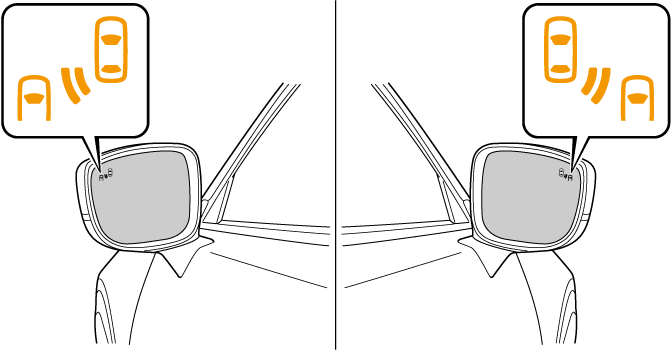i-ACTIVSENSE
i-ACTIVSENSE (Some Models)
i-ACTIVSENSE is a collective term covering a series of advanced safety and driver support systems which make use of a Forward Sensing Camera (FSC) and radar sensors. These systems consist of active safety and pre-crash safety systems.
These systems are designed to assist the driver in safer driving by reducing the load on the driver and helping to avert collisions or reduce their severity. However, because each system has its limitations, always drive carefully and do not rely solely on the systems.
Active Safety Technology
Active Safety Technology supports safer driving by helping the driver to recognise potential hazards and avert accidents.
Driver awareness support systems
Nighttime visibility
Left/right side and rear side detection
Road sign recognition
Inter-vehicle distance recognition
Driver fatigue detection
Rear obstruction detection when leaving a parking space
Driver support systems
Inter-vehicle distance
Lane departure
Pre-Crash Safety Technology
Pre-crash safety technology is designed to assist the driver in averting collisions or reduce their severity in situations where they cannot be avoided.
Collision damage reduction in low vehicle speed range
Forward driving
Reverse driving
Collision damage reduction in medium/high speed range
Camera and Sensors
Forward Sensing Camera (FSC)
The Forward Sensing Camera (FSC) detects lane indications and recognises headlights, tail lights and city lights during nighttime driving. In addition, it also detects the vehicle ahead, pedestrians, or obstructions. The following systems also use the Forward Sensing Camera (FSC).
-
Adaptive LED Headlights (ALH)
-
Driver Attention Alert (DAA)
-
Lane-keep Assist System (LAS) & Lane Departure Warning System (LDWS)
-
Traffic Sign Recognition System (TSR)
-
Advanced Smart City Brake Support (Advanced SCBS)
-
Smart Brake Support (SBS)
-
Mazda Radar Cruise Control with Stop & Go function (MRCC with Stop & Go function)
The Forward Sensing Camera (FSC) is installed at the top of the windscreen near the rearview mirror.
Refer to Forward Sensing Camera (FSC) (Search).
Radar sensor (front)
The radar sensor (front) functions by detecting the radio waves reflected off a vehicle ahead sent from the radar sensor. The following systems also use the radar sensor (front).
-
Mazda Radar Cruise Control with Stop & Go function (MRCC with Stop & Go function)
-
Distance Recognition Support System (DRSS)
-
Smart Brake Support (SBS)
The radar sensor (front) is mounted behind the radiator grille.
Refer to Radar Sensor (Front) (Search).
Radar sensors (rear)
The radar sensors (rear) function by detecting the radio waves reflected off a vehicle approaching from the rear or an obstruction sent from the radar sensors. The following systems also use the radar sensors (rear).
-
Blind Spot Monitoring (BSM)
-
Rear Cross Traffic Alert (RCTA)
The radar sensors (rear) are installed inside the rear bumper, one each on the left and right sides.
Refer to Radar Sensors (Rear) (Search).
Ultrasonic sensors (rear)
The ultrasonic sensors (rear) function by detecting the ultrasonic waves reflected off obstructions at the rear sent from the ultrasonic sensors. The following systems also use the ultrasonic sensors (rear).
-
Smart City Brake Support [Reverse] (SCBS R)
The ultrasonic sensors (rear) are mounted in the rear bumper.
Refer to Ultrasonic Sensors (Rear) (Search).
Adaptive LED Headlights (ALH) (Some Models)
The ALH are a system which uses the Forward Sensing Camera (FSC) to determine the situation of a vehicle ahead or a vehicle approaching in the opposite direction while driving at night to automatically switch the illumination range of the headlights, the illuminated area, or the illumination brightness.
Refer to Forward Sensing Camera (FSC) (Search).
The ALH are controlled between high and low beams as follows to assure the driver’s visibility without dazzling a vehicle ahead or a vehicle approaching in the opposite direction.
Glare-Free High Beam
This feature dims only the high-beam light shone on the vehicle ahead.
The high beams will dim while driving at a speed of about 40 km/h (25 mph) or faster. When the vehicle speed is less than about 30 km/h (18 mph), the beams switch to the low beams.

Wide-Range Low Beam
This feature extends the illumination range of the light cast by the low beams while driving at a speed less than about 40 km/h (25 mph).
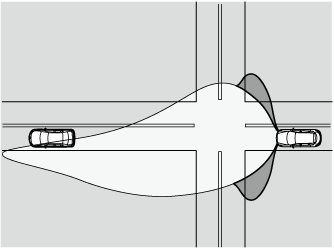
Highway Mode
This feature shifts the illumination angle of the light cast by the headlights upward while driving on highways.

The distance in which the ALH can detect objects varies depending on the surrounding conditions.
-
Do not modify the suspensions or headlight units, or remove the camera. Otherwise, the ALH may not operate normally.
-
Do not rely excessively on the ALH and drive the vehicle while paying sufficient attention to safety. Switch the headlights between the high beams and low beams manually if necessary.
Under the following conditions, the ALH may not operate normally. Manually switch between the high and low beams according to the visibility, and the road and traffic conditions.
-
When there are other sources of light in the area such as street lamps, illuminated signboards, and traffic signals.
-
When there are reflective objects in the surrounding area such as reflective plates and signs.
-
When visibility is reduced under rain, snow and foggy conditions.
-
When driving on roads with sharp curves or undulations.
-
When the headlights/rear lamps of vehicles ahead or in the opposite lane are dim or not illuminated.
-
When there is insufficient darkness such as at dawn or dusk.
-
When the luggage compartment is loaded with heavy objects or the rear passenger seats are occupied.
-
When visibility is reduced due to a vehicle ahead spraying water from its tyres onto your windscreen.
To Operate the System
The system switches the headlights to the high beams after the ignition is switched ON and the headlight switch is in the  position. The ALH indicator light (green) in the instrument cluster turns on simultaneously.
position. The ALH indicator light (green) in the instrument cluster turns on simultaneously.

The ALH determine that it is nighttime based on the brightness of the surrounding area.
The system cancels operation when the headlight switch is turned to a position other than  , the headlights are manually switched to low beams, or the high beams are flashed on and off.
, the headlights are manually switched to low beams, or the high beams are flashed on and off.
The system can be changed so that the ALH do not operate.
Refer to Personalisation Features (Search).
Manual Switching
Switching to low beams
Shift the lever to the low beam position.
The ALH indicator light (green) turns off.
Switching to high beams
Turn the headlight switch to the  position.
position.
The ALH indicator light (green) turns off and the  is illuminated.
is illuminated.
Blind Spot Monitoring (BSM) (Some Models)
The BSM is designed to assist the driver in checking the area to the rear of the vehicle on both sides during lane changes by notifying the driver of the presence of vehicles approaching from the rear in an adjacent lane.
The BSM detects vehicles approaching from the rear while travelling in the forward direction at a speed of 10 km/h (6.3 mph) or faster and notifies the driver by turning on the BSM warning indicator light and displaying the vehicle detection screen (vehicles with multi-information display and active driving display).
If the direction indicator lever is operated to signal a turn in the direction in which the BSM warning indicator light is illuminated while the approaching vehicle is detected, the BSM notifies the driver of possible danger by turning on the BSM warning indicator light, and by activating the warning sound and the warning screen indicator display (vehicles with multi-information display and active driving display).
The detection area on this system covers the driving lanes on both sides of the vehicle and from the rear part of the front doors to about 50 m (164 ft) behind the vehicle.
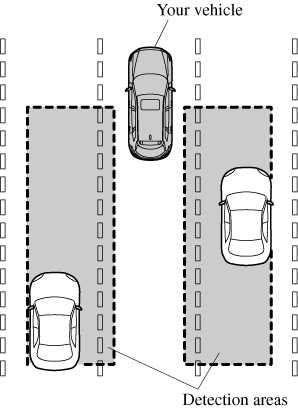
Always check the surrounding area visually before making an actual lane change:
The system is only designed to assist you in checking for vehicles at your rear when making a lane change. Due to certain limitations with the operation of this system, the BSM warning indicator light, the warning sound and the warning screen indicator display may not activate or they might be delayed even though a vehicle is in an adjacent driving lane. Always make it your responsibility as a driver to check the rear.
-
The BSM will operate when all of the following conditions are met:
-
The ignition is switched ON.
-
The BSM OFF indicator light in the instrument cluster is turned off.
-
The vehicle speed is about 10 km/h (6.3 mph) or faster.
-
-
The BSM will not operate under the following circumstances.
-
The vehicle speed falls below about 10 km/h (6.3 mph) even though the BSM OFF switch indicator light is turned off.
-
The selector lever is shifted to reverse (R) and the vehicle is reversing.
-
The turning radius is small (making a sharp turn, turning at intersections).
-
-
In the following cases, the BSM OFF indicator light turns on and operation of the system is stopped. If the BSM OFF indicator light remains illuminated, have the vehicle inspected at an Authorised Mazda Repairer as soon as possible.
-
Some problem with the system including the BSM warning indicator lights is detected.
-
A large deviation in the installation position of a radar sensor (rear) on the vehicle has occurred.
-
There is a large accumulation of snow or ice on the rear bumper near a radar sensor (rear). Remove any snow, ice or mud on the rear bumper.
-
Driving on snow-covered roads for long periods.
-
The temperature near the radar sensors (rear) becomes extremely hot due to driving for long periods on slopes during the summer.
-
The battery voltage has decreased.
-
-
Under the following conditions, the radar sensors (rear) cannot detect target objects or it may be difficult to detect them.
-
A vehicle is in the detection area at the rear in an adjacent driving lane but it does not approach. The BSM determines the condition based on radar detection data.
-
A vehicle is travelling alongside your vehicle at nearly the same speed for an extended period of time.
-
Vehicles approaching in the opposite direction.
-
A vehicle in an adjacent driving lane is attempting to pass your vehicle.
-
A vehicle is in an adjacent lane on a road with extremely wide driving lanes. The detection area of the radar sensors (rear) is set at the road width of expressways.
-
-
In the following case, the flashing of the BSM warning indicator light, and the activation of the warning sound and the warning screen indicator display may not occur or they may be delayed.
-
A vehicle makes a lane change from a driving lane two lanes over to an adjacent lane.
-
Driving on steep slopes.
-
Crossing the summit of a hill or mountain pass.
-
When there is a difference in the height between your driving lane and the adjacent lane.
-
Directly after the BSM system becomes operable by changing the setting.
-
-
If the road width is extremely narrow, vehicles two lanes over may be detected. The detection area of the radar sensors (rear) is set according to the road width of expressways.
-
The BSM warning indicator light may turn on and the vehicle detection screen may be displayed in the display in reaction to stationary objects (guardrails, tunnels, sidewalls, and parked vehicles) on the road or the roadside.

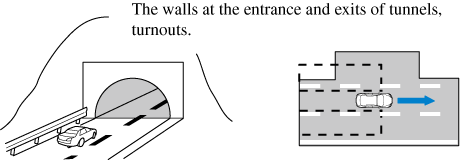
-
A BSM warning indicator light may flash or the warning beep and the warning screen indicator display may be activated several times when making a turn at a city intersection.
-
Turn off the BSM while pulling a trailer or while an accessory such as a bicycle carrier is installed to the rear of the vehicle. Otherwise, the radar’s radio waves will be blocked causing the system to not operate normally.
-
In the following cases, it may be difficult to view the illumination/flashing of the BSM warning indicator lights equipped on the door mirrors.
-
Snow or ice is adhering to the door mirrors.
-
The front door glass is fogged or covered in snow, frost or dirt.
-
-
The system switches to the Rear Cross Traffic Alert function when the selector lever is shifted to the reverse (R) position.
Refer to Rear Cross Traffic Alert (RCTA) (Search).
Blind Spot Monitoring (BSM) Warning Indicator Light/Display Indicator/Blind Spot Monitoring (BSM) Warning Beep
Cancelling Operation of Blind Spot Monitoring (BSM)
The BSM system can be set to inoperable.
Refer to Personalisation Features (Search).
When the BSM is set to inoperable, the BSM and Rear Cross Traffic Alert (RCTA) systems are turned off and the BSM OFF indicator light in the instrument cluster turns on.

When the ignition is switched OFF, the system status before it was turned off is maintained. For example, if the ignition is switched OFF while the BSM and Rear Cross Traffic Alert (RCTA) systems are operational, the BSM and Rear Cross Traffic Alert (RCTA) systems remain operational the next time the ignition is switched ON.
Traffic Sign Recognition System (TSR) (Some Models)
The TSR helps prevent the driver from overlooking traffic signs, and provides support for safer driving by displaying traffic signs on the active driving display which are recognised by the Forward Sensing Camera (FSC) or recorded in the navigation system while the vehicle is driven.
The TSR displays the speed limit (including auxiliary signs), do not enter, and traffic stop signs.
If the vehicle speed exceeds the speed limit sign indicated in the active driving display while the vehicle is driven, the system notifies the driver using the indication in the active driving display and a warning sound.
-
The TSR is not supported in some countries or regions. For information concerning the supported countries or regions, consult an expert repairer, we recommend an Authorised Mazda Repairer.
-
The TSR operates only if the navigation system SD card (Mazda genuine) is inserted in the SD card slot. Consult an expert repairer, we recommend an Authorised Mazda Repairer for details.
Speed limit signs (including auxiliary signs) and do not enter signs
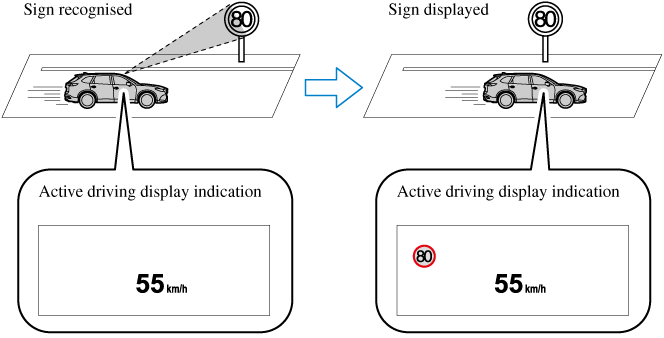
Stop sign
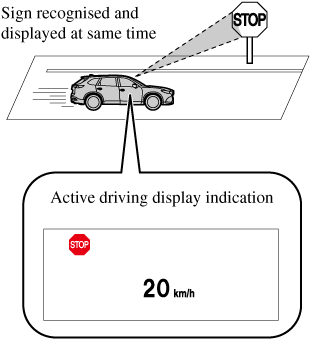
Always check the traffic signs visually while driving.
The TSR helps prevent the driver from overlooking traffic signs and provides support for safer driving. Depending on the weather conditions or problems with traffic signs, a traffic sign may not be recognised or a traffic sign different from the actual traffic sign may be displayed. Always make it your responsibility as a driver to check the actual traffic signs. Otherwise, it could result in an accident.
-
The TSR does not operate if there is a malfunction in the Forward Sensing Camera (FSC).
-
Under the following conditions, the TSR may not operate normally.
-
An object placed on the instrument panel is reflected in the windscreen and picked up by the camera.
-
Heavy luggage is loaded in the luggage compartment or on the rear seat and the vehicle is tilted.
-
The tyre pressures are not adjusted to the specified pressure.
-
Tyres other than standard tyres are equipped.
-
The vehicle is driven on the ramp and surrounding area to or from a rest area or a tollgate on a highway.
-
When surrounding brightness suddenly changes such as when entering or exiting a tunnel.
-
The illumination of the headlights is weakened because of dirt or the optical axis is deviated.
-
The windscreen is dirty or foggy.
-
The windscreen and camera are fogged (water droplets).
-
Strong light is directed at the front of the vehicle (such as backlight or high-beam headlights of on-coming vehicles).
-
The vehicle is making a sharp turn.
-
Strong light reflects off the road.
-
A traffic sign is in a position which makes it difficult to reflect the light from the vehicle's headlights, such as when the vehicle is driven at night or in a tunnel.
-
The vehicle is driven under weather conditions such as rain, fog, or snow.
-
The stored map data for the navigation system is not current.
-
A traffic sign is obscured by mud or snow.
-
A traffic sign is concealed by trees or a vehicle.
-
A traffic sign is partially shaded.
-
A traffic sign is bent or warped.
-
A traffic sign is too low or too high.
-
A traffic sign is too bright or too dark (including electronic traffic signs).
-
A traffic sign is too big or too small.
-
There is an object similar to the traffic sign being read (such as another traffic sign or other signs resembling it).
-
-
The TSR does not operate if the active driving display is set to non-display.
-
The TSR can be set to inoperable.
Refer to Personalisation Features (Search).
Traffic Sign Display Indication
The following traffic signs are displayed on the active driving display.
Speed limit signs (including auxiliary signs)
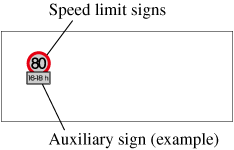
If the Forward Sensing Camera (FSC) cannot classify an auxiliary sign (such as time restrictions, turning restrictions, end of section) correctly, the following screen is displayed.

Do not enter signs

Stop signs

If the Forward Sensing Camera (FSC) cannot correctly recognise a traffic sign while the vehicle is driven, the following screen is displayed.

Speed limit signs (including auxiliary signs)
-
When the vehicle speed is about 1 km/h (0.6 mph) or faster, the speed limit sign is displayed when any one of the following conditions are met.
-
The Forward Sensing Camera (FSC) recognises a speed limit sign as a sign targeted for your vehicle and the vehicle passes it.
-
The speed limit sign stored in the navigation system is read (if the Forward Sensing Camera (FSC) does not recognise a speed limit sign).
-
-
In the following cases, display of the speed limit sign stops.
-
The Forward Sensing Camera (FSC) recognises the speed limit sign and the vehicle is driven for a certain distance after passing the sign.
-
Each sensor determines that the vehicle has changed direction of travel.
-
The Forward Sensing Camera (FSC) recognises a new speed limit sign which differs from the previous one (displays the new speed limit sign).
-
The speed limit sign stored in the navigation system is not read within a certain period of time (if the Forward Sensing Camera (FSC) does not recognise a speed limit sign, the speed limit sign stored in the navigation system is displayed).
-
The vehicle speed exceeds the displayed speed limit sign by 30 km/h (19 mph) or more after a certain period of time has elapsed since the speed limit sign was displayed. (Except when there is information for the speed limit sign in the navigation system)
-
Do not enter signs
-
A do not enter sign is displayed when all of the following conditions are met.
-
The vehicle speed is about 80 km/h (50 mph) or slower.
-
The Forward Sensing Camera (FSC) recognises a do not enter sign as a sign targeted for your vehicle and the vehicle passes it.
-
-
When the Forward Sensing Camera (FSC) recognises the do not enter sign and a certain period of time has elapsed since the vehicle passed the sign, display of the do not enter sign stops.
Stop sign
-
A stop sign is displayed when all of the following conditions are met:
-
The vehicle speed is about 30 km/h (19 mph) or slower.
-
The Forward Sensing Camera (FSC) recognises a stop sign as a sign targeted for your vehicle.
-
-
When a certain period of time has elapsed since the stop sign was displayed, display of the stop sign stops.
Excessive Speed Warning
If the vehicle speed exceeds the speed limit sign displayed in the active driving display, the area around the speed limit sign flashes three times in amber and the warning sound is activated three times at the same time. If the vehicle speed continues to exceed the displayed speed limit sign, the indication stops flashing and remains on. Check the surrounding conditions and adjust the vehicle speed to the legal speed using the appropriate operation such as depressing the brake pedal.
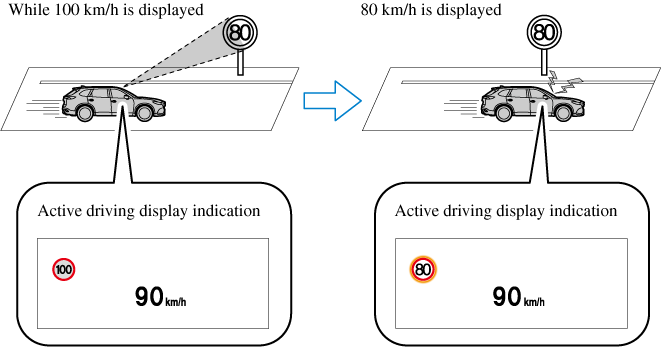
The excessive speed warning is initially set to inoperable. If you want to activate the excessive speed warning, change the setting in the personalisation features. In addition, the warning pattern and the warning activation timing differ depending on the setting contents.
Refer to Personalisation Features (Search).
Warning pattern
-
Off: The excessive speed warning is not activated.
-
Visual: The area around the speed limit sign displayed in the display flashes three times in amber, and if the vehicle speed continues to exceed the displayed speed limit sign, the indication stops flashing and remains on.
-
Audio & Visual: The area around the speed limit sign displayed in the display flashes three times in amber and the warning sound is activated three times at the same time. If the vehicle speed continues to exceed the displayed speed limit sign, the indication stops flashing and remains on.
Warning activation timing
-
 0: If the vehicle speed exceeds the speed limit sign displayed in the display, the excessive speed warning is activated.
0: If the vehicle speed exceeds the speed limit sign displayed in the display, the excessive speed warning is activated. -
 5: If the vehicle speed exceeds the speed limit sign displayed in the display by 5 km/h (3 mph), the excessive speed warning is activated.
5: If the vehicle speed exceeds the speed limit sign displayed in the display by 5 km/h (3 mph), the excessive speed warning is activated. -
 10: If the vehicle speed exceeds the speed limit sign displayed in the display by 10 km/h (6.2 mph), the excessive speed warning is activated.
10: If the vehicle speed exceeds the speed limit sign displayed in the display by 10 km/h (6.2 mph), the excessive speed warning is activated.
-
In the following cases, the excessive speed warning stops operating.
-
The vehicle speed is less than the speed of the displayed speed limit sign. (If the activation timing for the excessive speed warning is changed in the personalisation features, the excessive speed warning stops operating when the vehicle speed is less than the changed vehicle speed.
-
A speed limit sign indication has been updated and the vehicle speed is lower than the updated indication.
-
Display of the speed limit sign stops.
-
-
The warning indication is displayed at the same time the excessive speed warning sound is activated if the vehicle speed exceeds the speed indicated on the speed limit sign.
Refer to Warning Sound is Activated (Search).
-
The TSR can recognise a speed limit sign with an auxiliary sign and display it, but it cannot determine the indication on the auxiliary sign (such as time restrictions, turning restrictions, end of section). Therefore, the excessive speed warning is activated when the vehicle speed exceeds the displayed speed limit sign even if the conditions indicated on the auxiliary sign do not apply to the vehicle.
-
If the Forward Sensing Camera (FSC) incorrectly recognises the actual speed limit sign at a lower speed, the excessive speed alarm is activated even if the vehicle is driven at the legal speed.
Distance Recognition Support System (DRSS) (Some Models)
The DRSS measures the distance between your vehicle and a vehicle ahead using a radar sensor (front) while the vehicle speed is about 30 km/h (19 mph) or faster, and if your vehicle approaches a vehicle ahead more closely than what is appropriate for maintaining distance between the vehicles according to the vehicle speed, a notification in the active driving display is indicated to advise you to keep a safe distance from the vehicle ahead.
Do not rely completely on the DRSS and always drive carefully:
The DRSS provides advice for safer driving and notifies the driver of a recommended, safer distance to maintain with a vehicle ahead. The ability to detect a vehicle ahead is limited depending on the type of vehicle ahead, the weather conditions, and the traffic conditions. Therefore, if the accelerator and brake pedals are not operated correctly it could lead to an accident. Always verify the safety of the surrounding area and depress the brake pedal or accelerator pedal while keeping a safer distance from vehicles ahead or on-coming vehicles.
-
The DRSS operates when all of the following conditions are met:
-
The ignition is switched ON.
-
The DRSS is on.
-
The selector lever is in a position other than reverse (R).
-
The vehicle speed is 30 km/h or faster (19 mph or faster).
-
-
The objects which activate the system are 4-wheeled vehicles.
-
The DRSS may also operate in the presence of motorcycles and bicycles.
-
The DRSS may not operate normally under the following conditions:
-
The Dynamic Stability Control (DSC) has a malfunction.
-
The vehicle ahead is travelling at an extremely slow speed.
-
-
The system does not operate with the following objects:
-
Vehicles approaching in the opposite direction.
-
Stationary objects (stopped vehicles, obstructions)
-
Indication on Display
The DRSS operation status is indicated in the active driving display or multi-information display. Regarding malfunctions, check the vehicle conditions or have it inspected by an expert repairer, we recommend an Authorised Mazda Repairer according to the content of the displayed message.
Refer to Warning/Indicator Lights (Search).
-
When the ignition is switched off, the operation status before the system was turned off is maintained. For example, if the ignition is switched off with the DRSS operable, the system will be operable when the ignition is switched ON the next time.
-
The DRSS can be turned on/off and the system's sensitivity can be changed.
Refer to Personalisation Features (Search).
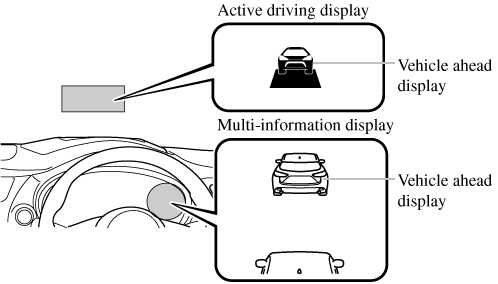
Distance-between-vehicles guidelines*1
|
Indication on display |
Distance between vehicles guidelines (During travel at about 40 km/h (25 mph) |
Distance between vehicles guidelines (During travel at about 80 km/h (50 mph) |
|
|---|---|---|---|
|
Multi-information display |
Active driving display |
||
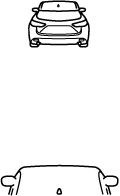 |
 |
About 25 m (82 ft) |
About 50 m (164 ft) |
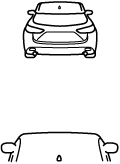 |
About 20 m (66 ft) |
About 40 m (131 ft) |
|
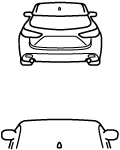 |
About 15 m (49 ft) |
About 30 m (98 ft) |
|
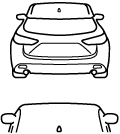 |
About 10 m (33 ft) |
About 20 m (66 ft) |
|
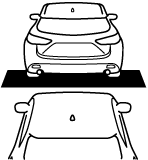 Flashes in white*2 |
 |
About 10 m (32 ft) or less |
About 20 m (65 ft) or less |
-
The distance between vehicles differs depending on vehicle speed.
-
Indication when the distance setting for notifying the driver that the vehicle approaches a vehicle ahead is Near.
Driver Attention Alert (DAA) (Some Models)
The DAA is a system which detects driver fatigue and decreased attentiveness, and encourages the driver to take a rest.
When the vehicle is driven inside traffic lane lines at about 65 to 140 km/h (41 to 86 mph), the DAA estimates the amount of accumulated fatigue and decreased attentiveness of the driver based on the information from the Forward Sensing Camera (FSC) and other vehicle information, and encourages the driver to take a rest using an indication on the multi-information display and a warning sound.
Use the DAA on expressways or highways.
Refer to Forward Sensing Camera (FSC) (Search).
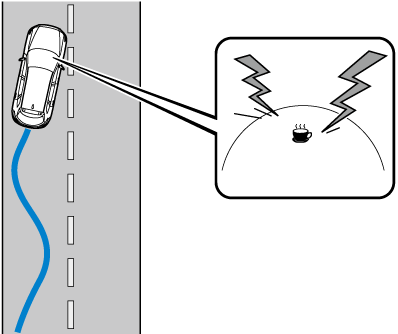
Do not rely completely on DAA and always drive carefully:
The DAA detects driver fatigue and decreased attentiveness and encourages the driver to take a rest, however, it is not designed to prevent the vehicle from straying. If you rely too much on the DAA it could lead to an accident. Drive carefully and operate the steering wheel appropriately.
In addition, the system may not be able to detect driver fatigue and decreased attentiveness correctly depending on the traffic and driving conditions. The driver must take sufficient rest in consideration of safer driving.
-
The DAA operates when all of the following conditions are met.
-
The vehicle speed is about 65 to 140 km/h (41 to 86 mph).
-
The system detects white (yellow) lane lines.
-
The system has completed learning of the driver’s driving data.
-
-
The DAA does not operate under the following conditions.
-
The vehicle speed is less than about 65 km/h (41 mph).
-
The vehicle speed exceeds about 140 km/h (86 mph)
-
The vehicle is making a sharp turn.
-
The vehicle is changing lanes.
-
-
The DAA may not operate normally under the following conditions.
-
White (yellow) lane lines are less visible because of dirt or fading/patchiness.
-
The vehicle is jolted or swayed continuously by strong winds or rough roads.
-
The vehicle is driven aggressively.
-
When making frequent lane changes.
-
-
The DAA detects driver fatigue and decreased attentiveness based on the driving data when the vehicle is driven at about 65 to 140 km/h (41 to 86 mph) for about 20 minutes. The driving data will be reset under the following conditions.
-
The vehicle is stopped for 15 minutes or longer.
-
The vehicle is driven at less than about 65 km/h (41 mph) for about 30 minutes.
-
The ignition is switched off.
-
-
After the DAA has displayed the first message encouraging rest, it does not display the next one until 45 minutes have passed.
Driver Attention Alert (DAA) Display
When the system detects driver fatigue or decreased attentiveness, it activates the warning sound and displays an alert in the multi-information display.
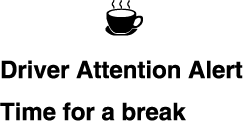
Cancelling Driver Attention Alert (DAA)
The DAA can be set to not activate.
Refer to Personalisation Features (Search).
Rear Cross Traffic Alert (RCTA) (Some Models)
The RCTA system is designed to assist the driver in checking the area to the rear of the vehicle on both sides while the vehicle is reversing by alerting the driver to the presence of vehicles approaching the rear of the vehicle.
The RCTA system detects vehicles approaching from the left and right sides of the vehicle, and the rear of the vehicle while the vehicle is being reversed out of a parking space, and notifies the driver of possible danger using the Blind Spot Monitoring (BSM) warning indicator lights and the warning buzzer.
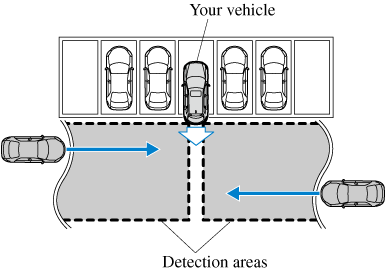
RCTA operation
-
The RCTA system operates when the selector lever is shifted to the reverse (R) position.
-
If there is the possibility of a collision with an approaching vehicle, the Blind Spot Monitoring (BSM) warning indicator lights flashes and the warning beep is activated simultaneously.
The RCTA warning indication in the rearview monitor also synchronizes with the Blind Spot Monitoring (BSM) warning indicator light on the door mirrors.
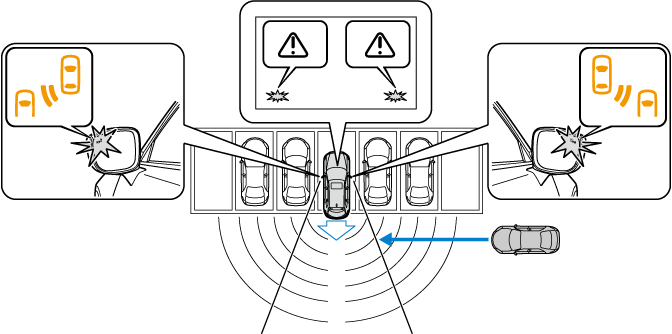
Always check the surrounding area visually before actually putting the vehicle in reverse:
The system is only designed to assist you in checking for vehicles at the rear when putting the vehicle in reverse. Due to certain limitations with the operation of this system, the Blind Spot Monitoring (BSM) warning indicator lights may not flash or it might be delayed even though a vehicle is behind your vehicle. Always make it your responsibility as a driver to check the rear.
-
In the following cases, the Blind Spot Monitoring (BSM) OFF Indicator Light turns on and operation of the system is stopped. If the Blind Spot Monitoring (BSM) OFF Indicator Light remains illuminated, have the vehicle inspected at an Authorised Mazda Dealer as soon as possible.
-
Some problem with the system including the Blind Spot Monitoring (BSM) warning indicator lights has occurred.
-
A large deviation in the installation position of a radar sensor (rear) on the vehicle has occurred.
-
There is a large accumulation of snow or ice on the rear bumper near a radar sensor (rear).
-
Driving on snow-covered roads for long periods.
-
The temperature near the radar sensors becomes extremely hot due to driving for long periods on slopes during the summer.
-
The battery voltage has decreased.
-
-
Under the following conditions, the radar sensors (rear) cannot detect target objects or it may be difficult to detect them.
-
The vehicle speed when reversing is about 15 km/h (9 mph) or faster.
-
The radar sensor (rear) detection area is obstructed by a nearby wall or parked vehicle. (Reverse the vehicle to a position where the radar sensor detection area is no longer obstructed.)
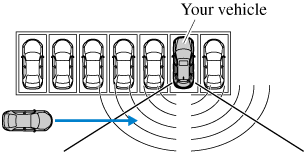
-
A vehicle is approaching directly from the rear of your vehicle.
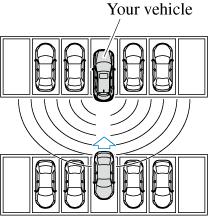
-
The vehicle is parked on a slant.
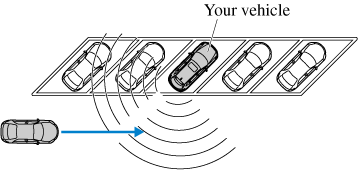
-
Directly after the Blind Spot Monitoring (BSM) system becomes operable using the personalisation feature.
-
Radio wave interference from a radar sensor equipped on a nearby parked vehicle.
-
-
In the following cases, it may be difficult to view the illumination/flashing of the Blind Spot Monitoring (BSM) warning indicator lights equipped on the door mirrors.
-
Snow or ice adheres to the door mirrors.
-
The front door glass is fogged or covered in snow, frost or dirt.
-
-
Turn off the RCTA system while pulling a trailer or while an accessory such as a bicycle carrier is installed to the rear of the vehicle. Otherwise, the radio waves emitted by the radar will be blocked causing the system to not operate normally.
Mazda Radar Cruise Control with Stop & Go function (MRCC with Stop & Go function) (Some Models)
The MRCC with Stop & Go function system is designed to maintain headway control*1 with a vehicle ahead according to your vehicle's speed using a radar sensor (front) to detect the distance to the vehicle ahead and a preset vehicle speed without you having to use the accelerator or brake pedals.
-
Headway Control: Control of the distance between your vehicle and the vehicle ahead detected by the Mazda Radar Cruise Control (MRCC) system.
Additionally, if your vehicle starts closing in on the vehicle ahead such as if the vehicle ahead brakes suddenly, a warning sound and a warning indication in the display are activated simultaneously to alert you to maintain a sufficient distance between the vehicles.
If the vehicle ahead stops while you are following behind it, your vehicle will stop and be held stopped automatically (stop hold control), and headway control will resume when you resume driving the vehicle such as by pressing the RES switch.
Also refer to the following before using the MRCC with Stop & Go function.
Do not rely completely on the MRCC with Stop & Go function:
The MRCC with Stop & Go function system has detection limitations depending on the type of vehicle ahead and its conditions, the weather conditions, and the road conditions. Additionally, the system may be unable to decelerate sufficiently to avoid hitting the vehicle ahead if the vehicle ahead applies the brakes suddenly or another vehicle cuts into the driving lane, which could result in an accident.
Always drive carefully and verify the surrounding conditions and depress the brake pedal or accelerator pedal while keeping a safer distance from vehicles ahead or on-coming vehicles.
Do not use the MRCC with Stop & Go function system in the following locations, using the MRCC with Stop & Go function system at the following locations may result in an unexpected accident:
-
General roads other than highways (Driving under these conditions using the MRCC with Stop & Go function system is not possible.)
-
Roads with sharp curves and where vehicle traffic is heavy and there is insufficient space between vehicles.
-
Roads where frequent and repetitive acceleration and deceleration occur (Driving under these conditions using the MRCC with Stop & Go function system is not possible).
-
When entering and exiting interchanges, service areas, and parking areas of highways (If you exit a highway while headway control is in use, the vehicle ahead will no longer be tracked and your vehicle may accelerate to the set speed).
-
Slippery roads such as ice or snow-bound roads (Tyres could spin causing you to lose vehicle control, or the stop hold control may not operate.)
-
Long, descending slopes (to maintain distance between vehicles, the system automatically and continuously applies the brakes which could result in the loss of brake power.)
-
Slopes with a steep gradient (The vehicle ahead may not be detected correctly, your vehicle may slide while stopped by the stop hold control, and it may accelerate suddenly after it starts moving.)
For safety purposes, switch the MRCC with Stop & Go function system off when it is not being used.
Do not get out of the vehicle while the stop hold control is operating:
Getting out of the vehicle while the stop hold control is operating is dangerous as the vehicle may move unexpectedly and result in an accident. Before getting out of the vehicle, switch the MRCC with Stop & Go function system off, shift the selector lever to the P position, and apply the electric parking brake (EPB).
If your vehicle is towed or you are towing something, switch the MRCC with Stop & Go function system off to prevent a miss-operation.
-
The MRCC with Stop & Go function system does not detect the following as physical objects.
-
Vehicles approaching in the opposite direction
-
Pedestrians
-
Stationary objects (stopped vehicles, obstructions)
-
If a vehicle ahead is travelling at an extremely low speed, the system may not detect it correctly.
-
-
During headway control travel, do not set the system for detection of two-wheeled vehicles such as motorcycles and bicycles.
-
Do not use the MRCC with Stop & Go function system under conditions in which close proximity warnings are frequently activated.
-
During headway control travel, the system accelerates and decelerates your vehicle in conjunction with the speed of the vehicle ahead. However, if it is necessary to accelerate for a lane change or if the vehicle ahead brakes suddenly causing you to close in on the vehicle rapidly, accelerate using the accelerator pedal or decelerate using the brake pedal depending on the conditions.
-
While the MRCC with Stop & Go function system is in use, it does not cancel even if the selector lever is operated and any intended engine braking does not occur. If deceleration is required, lower the set speed or depress the brake pedal.
-
The sound of the automatic brakes operating may be heard, however, it does not indicate a problem.
-
The brake lights turn on while the MRCC with Stop & Go function automatic braking is operating, however, they may not turn on while the vehicle is on a downslope at the set vehicle speed or travelling at a constant speed and following a vehicle ahead.
Mazda Radar Cruise Control with Stop & Go function (MRCC with Stop & Go function) Display Indication
The MRCC with Stop & Go function setting status and operation conditions are indicated on the multi-information display and the active driving display.
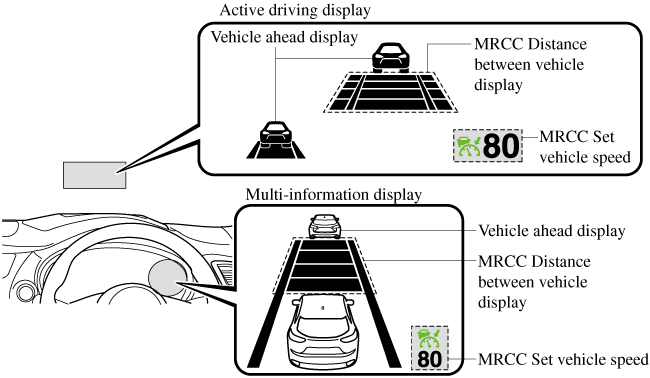
If there is a problem with the MRCC with Stop & Go function system, a message is displayed on the multi-information display. Check the centre display to verify the problem and then have your vehicle inspected by an expert repairer, we recommend an Authorised Mazda Repairer.
Refer to Message Indicated on Display (Search).
Close Proximity Warning
If your vehicle rapidly closes in on the vehicle ahead because the vehicle ahead applies the brakes suddenly while you are travelling in headway control, the warning sound activates and the brake warning is indicated in the display. Always verify the safety of the surrounding area and depress the brake pedal while keeping a safer distance from the vehicle ahead. Additionally, keep a safer distance from the vehicles behind you.
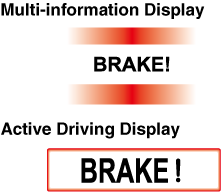
In the following cases, the warnings and brakes may not operate even if your vehicle starts closing in on the vehicle ahead.
-
You are driving your vehicle at the same speed as the vehicle ahead.
-
Directly after the MRCC with Stop & Go function system has been set.
-
Directly after the accelerator pedal is released.
-
Another vehicle cuts into the driving lane.
Setting the System
The MRCC with Stop & Go function system operates when all of the following conditions are met.
-
Vehicle speed is 0 km/h (0 mph) to 145 km/h (90 mph)
-
The MRCC with Stop & Go function is turned on.
-
The brake pedal is not depressed.
-
The electric parking brake (EPB) is released (electric parking brake (EPB) indicator light is turned off).
-
There is no problem with the DSC.
-
All the doors are closed.
-
The driver's seat belt is fastened.
-
The selector lever is in the drive (D) position or manual (M) position (manual mode).
-
In the following cases, the MRCC with Stop & Go function system is cancelled when the vehicle is travelling at 30 km/h (19 mph) or less and “Mazda Radar Cruise Control disabled under 30 km/h” is displayed in the multi-information display.
-
The Forward Sensing Camera (FSC) cannot detect target objects (There is problem with the Forward Sensing Camera (FSC) or windscreen is dirty).
-
There is a problem with the stop hold control function.
-
There is a problem with the electric parking brake (EPB).
-
-
It may not be possible to set the MRCC with Stop & Go function system directly after starting the engine, while the DSC operation is being checked.
Turning on the system

When the MODE switch is pressed once, the MRCC with Stop & Go function system turns on, and the MRCC with Stop & Go function main indication (white) turns on and the vehicle speed and the distance between the vehicles while in headway control can be set.

In addition, the MRCC with Stop & Go function system display indication is displayed on the multi-information display and the active driving display at the same time.
-
If the ignition is switched off while the MRCC with Stop & Go function system is operating, the system will be operable when the ignition is switched ON the next time.
-
The MRCC with Stop & Go function can switch to the cruise control function.
Refer to Cruise Control Function (Search).
How to set the speed
-
Adjust the vehicle speed to the desired setting using the accelerator pedal.
-
Headway control begins when the SET
 or SET
or SET switch is pressed.
switch is pressed.The set speed and the inter-vehicle distance display filled with white lines is displayed. The MRCC with Stop & Go function main indication (white) switches to the MRCC with Stop & Go function set indication (green) at the same time.

|
Travel status |
Indication on multi-information display |
Indication on active driving display |
|---|---|---|
|
During travel at constant speed |
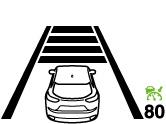 |
 |
|
During travel under headway control |
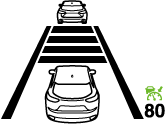 |
 |
-
If a vehicle ahead is detected while travelling at a constant speed, the vehicle-ahead indication is displayed and headway control is performed. Additionally, when a vehicle ahead is no longer detected, the vehicle-ahead indication turns off and the system switches back to travel at constant speed.
-
The lowest possible speed which can be set on the MRCC with Stop & Go function system is 30 km/h (19 mph).
-
Headway control is not possible if the vehicle ahead is driving faster than your vehicle's set speed. Adjust the system to the desired vehicle speed using the accelerator pedal.
How to set the distance-between-vehicles during headway control
The distance-between-vehicles is set to a shorter distance by pressing the  switch. The distance-between-vehicles is set to a longer distance by pressing the
switch. The distance-between-vehicles is set to a longer distance by pressing the  switch. The distance-between-vehicles can be set to 4 levels; Long, medium, short, and extremely short distance.
switch. The distance-between-vehicles can be set to 4 levels; Long, medium, short, and extremely short distance.
|
Distance-between-vehicles guideline (at 80 km/h (50 mph) vehicle speed) |
Indication on multi-information display |
Indication on active driving display*1 |
|---|---|---|
|
Long (about 50 m (164 ft)) |
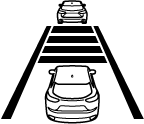 |
 |
|
Medium (about 40 m (131 ft)) |
 |
 |
|
Short (about 30 m (98 ft)) |
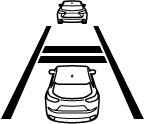 |
 |
|
Extremely short (about 25 m (82 ft)) |
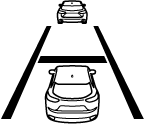 |
 |
-
Displays a pop-up image in the active driving display only when the driver operates the switch.
-
The distance-between-vehicles differs depending on the vehicle speed, and the slower the vehicle speed, the shorter the distance.
-
When the ignition is switched to ACC or OFF and then the engine is started again, the system automatically sets the distance-between-vehicles to the previous setting.
How to change the set vehicle speed
To accelerate/decelerate using the SET switch
When you press the SET switch, the vehicle accelerates and when you press the SET
switch, the vehicle accelerates and when you press the SET switch, it decelerates.
switch, it decelerates.
|
Short press |
5 km/h (5 mph) |
|
Long press |
10 km/h (5 mph) |
For example, the set vehicle speed is changed by pressing the SET switch four times as follows:
The vehicle speed accelerates or decelerates by 20 km/h (20 mph).
To increase speed using accelerator pedal
Depress the accelerator pedal and press and release the SET switch or SET
switch or SET switch at the desired speed. If the switch is not operated, the system returns to the set speed after you release your foot from the accelerator pedal.
switch at the desired speed. If the switch is not operated, the system returns to the set speed after you release your foot from the accelerator pedal.
The warnings and brake control do not operate while the accelerator pedal is depressed.
-
The setting speed can be changed by operating the SET
 switch or SET
switch or SET switch during stop hold control.
switch during stop hold control. -
When accelerating using the SET
 switch while in headway control, the set vehicle speed can be adjusted but acceleration is not possible. If there is no longer a vehicle ahead, acceleration continues until reaching the set vehicle speed. For the set vehicle speed, check the set vehicle speed indication in the display.
switch while in headway control, the set vehicle speed can be adjusted but acceleration is not possible. If there is no longer a vehicle ahead, acceleration continues until reaching the set vehicle speed. For the set vehicle speed, check the set vehicle speed indication in the display. -
When depressing the accelerator pedal, the inter-vehicle distance indication in the display changes to the white-line indication.
Cancelling the system
When the following operations are performed, the MRCC with Stop & Go function system is cancelled, and the MRCC with Stop & Go function set indication (green) switches to the MRCC with Stop & Go function main indication (white) at the same time.
-
The OFF/CAN switch is pressed.
-
The brake pedal is depressed.
-
The electric parking brake (EPB) is applied.
-
The selector lever is in the P (Park), N (Neutral), or R (Reverse) position.
-
Any of the doors is opened.
-
The driver's seat belt is unfastened.
Under the following conditions, the MRCC with Stop & Go function cancel indication is displayed in the multi-information display and a single beep sound is heard.
-
The DSC has operated.
-
The Smart Brake Support (SBS) has operated.
-
The Advanced Smart City Brake Support (Advanced SCBS) has operated.
-
When travelling on a downslope for a long period of time.
-
There is a problem with the system.
-
The engine has stalled.
-
The electric parking brake (EPB) is automatically applied during stop hold control.
-
The radar sensor (front) cannot detect target objects (during rain, fog, snow or other inclement weather conditions, or when the radiator grille is dirty).
Resuming control
If the MRCC with Stop & Go function system is cancelled, you can resume control at the previously set speed by pressing the RES switch and after all of the operation conditions have been met.
If the set speed is not indicated in the display, the control does not resume even if the RES switch is pressed.
Turning off the system
Press the OFF/CAN switch two times while the MRCC with Stop & Go function system is operating to switch off the system.
Stop Hold Control
While in headway control using the MRCC with Stop & Go function system, your vehicle will stop when a vehicle ahead stops. When the vehicle is stopped and the stop hold control operates, the MRCC with Stop & Go function indicator light turns on.

-
If the MRCC with Stop & Go function system is cancelled during stop hold control, the vehicle is held in its stopped position. The stop hold control can be cancelled by performing one the following actions.
-
Press the accelerator pedal and resume driving the vehicle.
-
While forcefully depressing the brake, switch the MRCC with Stop & Go function system off.
-
-
The electric parking brake (EPB) is automatically applied and the vehicle is held in its stopped position when 10 minutes have elapsed since the stop hold control operated. At this time, the MRCC with Stop & Go function system is cancelled.
-
If the i-stop operation conditions are met during stop hold control, the engine stops even though the brake pedal is not depressed.
Refer to i-stop (Search).
-
The brake lights turn on during stop hold control.
To resume driving
After the vehicle ahead starts moving while your vehicle is stopped under stop hold control, press the RES switch or depress the accelerator pedal to cancel the stop hold control and resume driving.
-
When you resume driving by pressing the RES switch, your vehicle does not start moving until the distance between your vehicle and the vehicle ahead lengthens to the specified distance or farther.
-
The engine restarts automatically when any of the actions to resume driving are performed while i-stop is operating.
-
If the MRCC with Stop & Go function is temporarily cancelled during stop hold control, you cannot resume driving by pressing the RES switch when there are no vehicles in front of your vehicle. Depress the accelerator pedal and resume driving the vehicle.
Resume driving information
If you do not resume driving within a few seconds after the vehicle ahead starts moving, the multi-information display vehicle-ahead indication flashes to urge the driver to resume driving.
Cruise Control Function
While this function is operating, the headway control operation is cancelled and only the cruise control function operates.
The vehicle speed can be set more than about 25 km/h (16 mph).
Use the cruise control function on expressways and other highways which do not require a lot of repeated acceleration and deceleration.
Do not use the cruise control function in the following locations:
Otherwise, it could lead to an accident.
-
Roads with sharp curves and where vehicle traffic is heavy and there is insufficient space between vehicles. (Driving under these conditions using the cruise control function is not possible)
-
Steep down slopes (Set speed may be exceeded because sufficient engine braking cannot be applied)
-
Slippery roads such as ice or snow-bound roads (Tyres could spin causing you to lose vehicle control)
Always drive carefully:
The warnings and brake control will not operate after the headway control function is cancelled and the system is switched to only the cruise control function. Depress the brake pedal to decelerate according to the surrounding conditions while keeping a safer distance from the vehicle ahead and always driving carefully.
Switching to cruise control function
When the MODE switch is pressed until the system switches to the cruise main indication (white) while the MRCC with Stop & Go function system is turned on, the system switches to the cruise control function.
When the system switches to the cruise control function, the indicator and multi-information display notify the driver as follows:
-
The MRCC with Stop & Go function set indication (green) or the MRCC with Stop & Go function main indication (white) is turned off, and the cruise main indication (white) is turned on.
-
A message is displayed in the multi-information display.
Always turn off the cruise control function when it is not in use:
Leaving the cruise control function turned on when it is not in use is dangerous as it could operate unexpectedly, resulting in an accident.
How to set the speed
Adjust the system to the desired vehicle speed using the accelerator pedal.
When the SET or SET
or SET switch is pressed, the cruise set indication (green) is turned on and headway control begins.
switch is pressed, the cruise set indication (green) is turned on and headway control begins.
-
The system may not be able to maintain the set speed constantly depending on driving conditions such as steep up or down slopes.
-
The speed will continue increasing while the SET
 switch is pressed and held. The speed will continue decreasing while the SET
switch is pressed and held. The speed will continue decreasing while the SET switch is pressed and held.
switch is pressed and held.
How to increase the set speed
The set speed can be increased using the following operations:
To increase speed using the SET switch
switch
Press and hold the SET switch and release the switch at the desired speed.
switch and release the switch at the desired speed.
The set speed can be adjusted incrementally (1 km/h (1 mph) increments) by pressing the switch and releasing it immediately. For example, if the switch is pressed 4 times, the set speed increases by about 4 km/h (4 mph).
To increase speed using accelerator pedal
Depress the accelerator pedal and press the SET or SET
or SET switch at the desired speed.
switch at the desired speed.
If the switch is not operated, the system returns to the set speed after you release your foot from the accelerator pedal.
How to Decrease the Set Speed
Press the SET switch continuously and release the switch at the desired speed.
switch continuously and release the switch at the desired speed.
The set speed can be adjusted incrementally (1 km/h (1 mph) increments) by pressing the switch and releasing it immediately. For example, if the switch is pressed 4 times, the set vehicle speed decreases by about 4 km/h (4 mph).
Cancelling the function
When the cruise control function is cancelled and the RES switch is pressed while the vehicle speed is 25 km/h (16 mph) or faster, the speed returns to the original set speed.
Cancelling using OFF/CAN switch
When the OFF/CAN switch is pressed once, the cruise control function is cancelled.
Automatically cancel
The cruise control function is cancelled automatically in the following cases.
-
The brake pedal is depressed.
-
The parking brake is applied.
-
The selector lever is shifted to P or N position.
-
If the vehicle speed decreases by about 15 km/h (9.4 mph) or more than the set speed, the cruise control function may be cancelled.
-
When the vehicle speed is less than 21 km/h (13 mph), the cruise control function is cancelled. In this case, the vehicle speed will not return to the original set speed even if the vehicle is accelerated to 25 km/h (16 mph) or higher and the RES switch is pressed. Reset the cruise control function.
Lane-keep Assist System (LAS) & Lane Departure Warning System (LDWS) (Some Models)
The LAS & LDWS alerts the driver that the vehicle may be deviating from its lane and it provides steering assistance to help the driver stay within the vehicle lanes.
The Forward Sensing Camera (FSC) detects the white lines (yellow lines) of the vehicle lane in which the vehicle is travelling and if the system determines that the vehicle may deviate from its lane, it operates the electric power steering to assist the driver's steering operation. The system also alerts the driver by activating a lane departure warning sound, vibrating the steering wheel, and indicating an alert in the display. Use the system when you drive the vehicle on roads with white (yellow) lines such as expressways and highways.
Refer to Forward Sensing Camera (FSC) (Search).
The steering wheel operation of the LAS & LDWS has “Late” and “Early” steering assist timing settings.
For the “Late” setting, the system assists the driver's steering operation if there is the possibility of the vehicle deviating from its lane.
For the “Early” setting, the system assists the driver's steering operation constantly so that the vehicle stays near the centre of the vehicle lane.
“Late” and “Early” timing can be changed (timing at which steering operation assist is provided) by changing the setting.
Refer to Personalisation Features (Search).
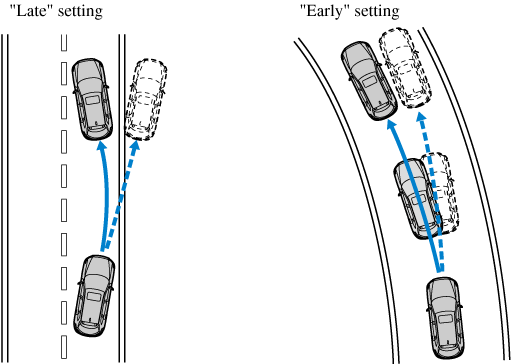
Do not rely completely on the LAS & LDWS:
-
The LAS & LDWS is not an automatic driving system. In addition, the system is not designed to compensate for a driver's lack of caution, and over-reliance on the system could lead to an accident.
-
The detection ability of the LAS & LDWS is limited. Always stay on course using the steering wheel and drive with care.
Do not use the LAS & LDWS in the following cases:
The system may not operate adequately according to the actual driving conditions, resulting in an accident.
-
Driving on roads with tight curves.
-
Driving under bad weather conditions (rain, fog, and snow).
-
Slippery roads such as ice or snow-bound roads.
-
Roads with heavy traffic and insufficient distance between vehicles.
-
Roads with no white (yellow) lane lines.
-
Narrow roads resulting from road construction or lane closures.
-
The vehicle is driven on a temporary lane or section with a closed lane resulting from road construction where there may be multiple white (yellow) lane lines or they are interrupted.
-
Vehicle is driven on roads other than expressways and highways.
-
The tyre pressures are not adjusted to the specified pressure.
-
Tyres of a different specified size are used, such as an emergency spare tyre.
Heed the following cautions so that the LAS & LDWS can operate normally.
-
Do not modify the suspensions.
-
Always use wheels of the specified type and size for the front and rear wheels. Consult an expert repairer, we recommend an Authorised Mazda Repairer for tyre replacement.
-
When the direction indicator lever is operated for a lane change, the LAS & LDWS is automatically disabled. The LAS & LDWS becomes operational again when the direction indicator lever is returned and the system detects white (yellow) lane lines while the vehicle is being driven normally within its vehicle lane.
-
If the steering wheel, accelerator pedal, or brake pedal is operated abruptly and the vehicle moves close to a white (yellow) line, the system determines that the driver is making a lane change and the LAS & LDWS operation is temporarily cancelled. The LAS & LDWS becomes operational again when the system detects white (yellow) lane lines while the vehicle is being driven normally within its vehicle lane.
-
If the vehicle deviates from its lane repeatedly within a short period of time, the LAS & LDWS may not operate.
-
When white (yellow) lane lines are not detected, the LAS & LDWS does not operate.
-
Under the following conditions, the LAS & LDWS may not be able to detect white (yellow) lane lines correctly and it may not operate normally.
-
If an object placed on the instrument panel is reflected in the windscreen and picked up by the camera.
-
Heavy luggage is loaded in the luggage compartment or on the rear seat and the vehicle is tilted.
-
The tyre pressures are not adjusted to the specified pressure.
-
Tyres other than conventional tyres are equipped.
-
Vehicle is driven on an intersection or junction, or on a forked road.
-
The white (yellow) lane lines are less visible because of dirt or fading/patchiness.
-
A vehicle in front of your vehicle is running near a white (yellow) lane line making it less visible.
-
A white (yellow) lane line is less visible because of bad weather (rain, fog, or snow).
-
The vehicle is driven on a temporary lane or section with a closed lane resulting from construction where there may be multiple white (yellow) lane lines or they are interrupted.
-
A misleading line is picked up on the road such as a temporary line for construction, or because of shade, lingering snow, or grooves filled with water.
-
The surrounding brightness suddenly changes such as when entering or exiting a tunnel.
-
The illumination of the headlights is weakened because of dirt or the optical axis is deviated.
-
The windscreen is dirty or foggy.
-
The windscreen, camera is fogged (water droplets).
-
Back-light is reflected off the road surface.
-
The road surface is wet and shiny after rain, or there are puddles on the road.
-
The shade of a guardrail parallel to a white (yellow) lane line is cast on the road.
-
The width of the driving lane is narrow or wide.
-
Driving on roads with tight curves.
-
The road is excessively uneven.
-
The vehicle is shaken after hitting a road bump.
-
There are two or more adjacent white (yellow) lane lines.
-
There are various road markings or lane markings of various shapes near an intersection.
-
System Operation
Make sure that the LAS & LDWS OFF switch indicator light is turned off. When the LAS & LDWS OFF switch indicator light is turned on, press the switch and make sure that the switch indicator light turns off.
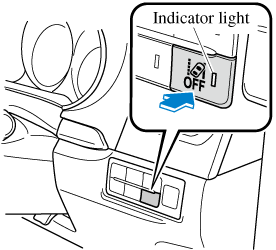
The LAS & LDWS indication (white) is displayed in the multi-information display, and the system goes on stand-by.

Drive the vehicle in the centre of the vehicle lane while the system is on standby. When all of the following conditions are met, the LAS & LDWS indication (green) is displayed in the multi-information display, and the system becomes operational.

-
The engine is running.
-
The vehicle speed is about 60 km/h (37 mph) or faster.
-
The system detects white (yellow) lane lines on both the right and left sides.
-
The driver is operating the steering wheel.
-
The driving lane is neither narrow nor wide.
The LAS & LDWS indication is white when the system detects only a white (yellow) line on either the left or right, and the indication changes to green when the system detects white (yellow) lines on both the left and right sides.
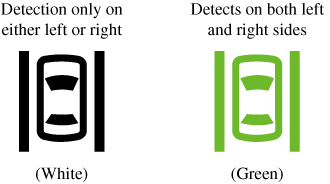
The LAS & LDWS goes on stand-by status in the following cases:
-
The system cannot detect white (yellow) lane lines.
-
The vehicle speed is less than about 60 km/h (37 mph).
-
The ABS/TCS is operating.
-
The TCS is turned off.
(If the TCS is turned off while the system is operational, a warning beep is heard and the system goes on standby.)
-
The vehicle is making a sharp curve.
-
The brake pedal is depressed.
-
The steering wheel is operated abruptly.
-
The width of a lane is excessively narrow or wide.
-
(When the timing of the steering assist is set to “Late”)
-
The LAS & LDWS does not operate until the system detects white (yellow) lane lines on either the left or right.
-
When the system detects a white (yellow) lane line on one side only, the system will not operate the steering wheel operation assist and the warning for the lane line on the side that is not being detected. The steering wheel operation assist and the warning is only for a lane deviation on the side that is being detected.
-
-
(When the timing of the steering assist is set to “Early”)
-
When the steering assist timing is set to “Early”, the LAS & LDWS does not operate until the system detects white (yellow) lane lines on the left and right. When the system only detects white (yellow) lane lines on either the left or right, the system only operates for a lane deviation on the side being detected.
-
The steering wheel operation assist is performed so that the vehicle remains near the centre of the driving lane, however, depending on conditions such as the road curvature, road slope and undulations, and vehicle speed, the system may not be able to keep the vehicle near the centre of the driving lane.
-
-
If the driver takes his or her hands off the steering wheel (not holding the steering wheel), the warning sound is activated and an alert is indicated in the multi-information display or the active driving display.
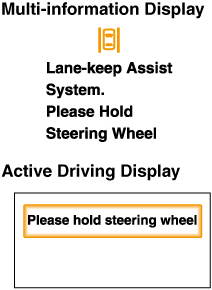
If the steering wheel is held lightly, or depending on the road conditions, the system may detect that you have released the steering wheel (not holding the steering wheel) even if you are holding it, and display a message in the multi-information display or the active driving display.
-
The timing at which the lane departure warning is activated and the steering wheel operation assist is performed varies.
-
The following settings for the LAS & LDWS can be changed. Refer to Personalisation Features (Search).
-
Steering operation assist operational/non-operational
-
Cancel sensitivity (likelihood of steering assist)
-
Vehicle lane line display
When the LAS & LDWS becomes operational while on standby, the vehicle lane lines are displayed in the multi-information display and the active driving display. In the vehicle lane lines display indicating the operation status, the colour of the vehicle lane lines being detected changes to white.
(Stand-by status)
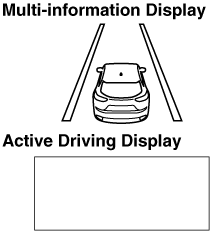
(Operational status)
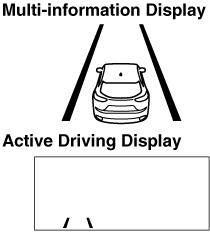
Auto cancel
In the following cases, the LAS & LDWS is automatically cancelled, the LAS & LDWS warning indication (amber) turns on, and an alert is displayed. When the LAS & LDWS become operational, the system turns back on automatically.
-
The temperature inside the camera is high or low.
-
The windscreen around the camera is foggy.
-
The windscreen around the camera is blocked by an obstruction, causing poor forward visibility.
Auto cancel of warning/steering assist
When the following operations are performed, the LAS & LDWS operation is cancelled automatically. The LAS & LDWS resumes automatically after the operation.
-
The steering wheel is operated abruptly.
-
The brake pedal is operated.
-
The accelerator pedal is operated.
(To cancel the automatic sensitivity cancel function, deselect “Cancel sensitivity” in the personalisation features setting.)
-
The direction indicator lever is operated.
-
The vehicle crosses a lane line.
-
After the operation, the LAS & LDWS operation may not operate for a period of 5 seconds at the most until the lane lines are detected.
-
Under the following conditions, the LAS & LDWS cancels the warning/steering assist automatically.
-
The driver takes his/her hands off the steering wheel.
(The LAS & LDWS is designed to assist the driver's steering operation and it will resume operation automatically when the driver holds the steering wheel.)
-
The TCS OFF switch is pressed to cancel the TCS.
-
Steering operation assist OFF (non-operational)
The steering operation assist for the LAS & LDWS can be changed to non-operational (OFF).
Refer to Setting Change (Personalisation Features) (Search).
When the steering operation assist has been changed to non-operational (OFF), the operation conditions and the display of the LAS & LDWS differ. Operate the system as follows:
System operation
Make sure that the LAS & LDWS OFF switch indicator light is turned off. When the LAS & LDWS OFF switch indicator light turns on, press the switch and make sure that the switch indicator light turns off.

Drive the vehicle in the centre of the driving lane while the LAS & LDWS OFF switch indicator light is turned off.
The system becomes operational when all of the following conditions are met.
-
The system detects white (yellow) lane lines on both the right and left sides or on either side.
-
The vehicle speed is about 60 km/h (37 mph) or faster.
-
The vehicle is driven on a straight road or road with gentle curves.
-
The engine is running.
The LAS & LDWS goes on stand-by status in the following cases:
-
The system cannot detect white (yellow) lane lines.
-
The vehicle speed is less than about 60 km/h (37 mph).
-
The vehicle is making a sharp curve.
-
The vehicle is making a curve at an inappropriate speed.
-
The LAS & LDWS remains on stand-by until it detects white (yellow) lines on both the left and right sides, or on either side.
-
When the system detects a white (yellow) lane line on one side only, the system will not activate warnings for the lane line on the side that is not being detected.
-
The distance and warning sensitivity (likelihood of a warning) which the system uses to determine the possibility of a lane departure can be changed.
Refer to Setting Change (Personalisation Features) (Search).
Vehicle lane line display
When the LAS & LDWS becomes operational while on standby, the vehicle lane lines are displayed in the multi-information display. The system changes to operational status display when the system detects a white (yellow) line on either the left or right.
(Stand-by status)
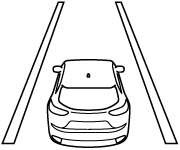
(Operational status)
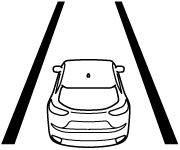
Auto cancel
In the following cases, the LAS & LDWS is automatically cancelled, the LAS & LDWS warning indication (amber) turns on, and an alert is displayed. When the LAS & LDWS become operational, the system turns back on automatically.
-
The temperature inside the camera is high or low.
-
The windscreen around the camera is foggy.
-
The windscreen around the camera is blocked by an obstruction, causing poor forward visibility.
(Auto cancel of warnings)
When the following operations are performed, the LAS & LDWS determines that the driver intends to make a lane change and the system operation is cancelled automatically. The LAS & LDWS resumes automatically after the operation.
-
The steering wheel is operated abruptly.
-
The brake pedal is depressed.
-
The accelerator pedal is depressed.
(To cancel the automatic sensitivity cancel function, deselect “Warning sensitivity” in the personalisation features setting.)
-
The direction indicator lever is operated.
-
The vehicle crosses a lane line.
System Cancelling
When the LAS & LDWS is turned off, press the LAS & LDWS OFF switch.

The LAS & LDWS OFF switch indicator light turns on.
-
In the following cases, the LAS & LDWS is cancelled automatically and the LAS & LDWS OFF indication is displayed in the multi-information display. Have your vehicle inspected at an expert repairer, we recommend an Authorised Mazda Repairer.
-
There is a malfunction in the power steering.
-
There is a malfunction in the TCS.
-
There is a malfunction in the Forward Sensing Camera (FSC).
-
-
When the ignition is switched OFF, the system status before it was turned off is maintained. For example, if the ignition is switched OFF with the lane-keep system operable, the system will be operable when the ignition is switched ON the next time.
When the LAS & LDWS is turned off, the vehicle lane line indication in the multi-information display and the active driving display turn off.
Lane Departure Warning
If the system determines that the vehicle may deviate from its lane, the lane departure warning (beep sound, rumble sound*1, or steering wheel vibration) is activated and the direction in which the system determines that the vehicle may deviate is indicated in the multi-information display and the active driving display.
For vehicles equipped with the multi-information display, the direction which the system determined that the vehicle may be deviating from its lane is indicated in the multi-information display.
For vehicles equipped with the active driving display, the colour of the lane line in the direction which the system determined that the vehicle may be deviating from its lane changes from white to amber and the vehicle lane line flashes.

-
If you have set the lane departure warning sound to the beep sound/rumble sound*1 setting, the warning sound may not be heard depending on the surrounding noise conditions.
-
If you have set the lane departure warning system to the steering wheel vibrations setting, the vibration may not be felt depending on the road surface conditions.
-
When the setting for the steering operation assist is changed to operational, the warnings can be set to activate/not activate. (When the setting for the steering operation assist is changed to non-operational, the warnings cannot be set to not activate.)
Refer to Setting Change (Personalisation Features) (Search).
-
The LAS & LDWS can be changed to the following settings regardless of whether the steering operation assist has been set to operational/non-operational. Always check the setting status when driving the vehicle and make setting changes if necessary.
Refer to Setting Change (Personalisation Features) (Search).
-
Steering wheel vibration: Strong/weak
-
Warning sound volume
-
Types of warnings (steering wheel vibration/beep sound/rumble sound*1)
-
-
A rumble strip is a series of grooves in the road pavement surface positioned at specific intervals, and when the vehicle passes over it a vibration and rumble sound is produced which alerts the driver that the vehicle is departing from the lane.
The rumble sound is a reproduction of the sound which occurs when a vehicle passes over a rumble strip.
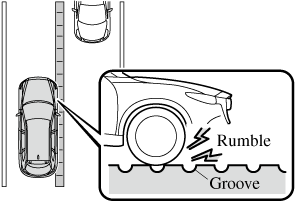
Advanced Smart City Brake Support (Advanced SCBS) (Some Models)
The Advanced SCBS alerts the driver of a possible collision using the display and a warning sound when the Forward Sensing Camera (FSC) detects a vehicle ahead or pedestrian and determines that a collision with the object is unavoidable while the vehicle is driven at a vehicle speed of about 4 to 80 km/h (2 to 50 mph) if the object is a vehicle ahead and about 10 to 80 km/h (6.2 to 50 mph) if the object is a pedestrian. In addition, the system reduces damage in the event of a collision by operating the brake control (Advanced SCBS brake) when the system determines that a collision is unavoidable. In addition, when the driver depresses the brake pedal, the brakes are applied firmly and quickly to assist. (Brake Assist (Advanced SCBS brake assist))
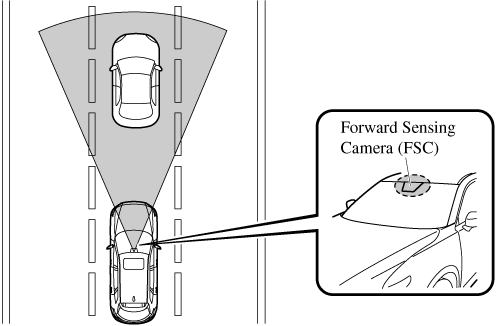
Do not rely completely on the Advanced SCBS system:
-
The Advanced SCBS system is only designed to reduce damage in the event of a collision. Over reliance on the system leading to the accelerator pedal or brake pedal being mistakenly operated could result in an accident.
-
The Advanced SCBS system operates in response to a vehicle ahead or a pedestrian. The system does not operate in response to obstructions such as a wall, 2-wheeled vehicles, or animals.
In the following cases, turn the system off to prevent a mis-operation:
-
The vehicle is being towed or when towing another vehicle.
-
The vehicle is on a chassis roller.
-
When driving on rough roads such as in areas of dense grass or off-road.
Refer to Stopping the Advanced Smart City Brake Support (Advanced SCBS) System Operation (Search) on how to turn off the Advanced SCBS system.
-
The Advanced SCBS system will operate under the following conditions.
-
The engine is running.
-
The Smart City Brake Support (SCBS) warning light (amber) does not illuminate.
-
(Object is vehicle ahead)
The vehicle speed is between about 4 to 80 km/h (2 to 50 mph).
-
(Object is a pedestrian)
The vehicle speed is between about 10 to 80 km/h (6.2 to 50 mph).
-
The Advanced SCBS system is not turned off.
-
-
Under the following conditions, the Advanced SCBS system may not operate normally:
-
The Advanced SCBS system will not operate if the driver is deliberately performing driving operations (accelerator pedal and steering wheel).
-
If there is the possibility of partial contact with a vehicle ahead.
-
The vehicle is driven on a slippery road surface such as wet roads or icy or snow-bound roads.
-
The braking performance is adversely affected due to cold temperatures or wet brakes.
-
The vehicle is driven at the same speed as the vehicle ahead.
-
The accelerator pedal is depressed.
-
The brake pedal is depressed.
-
The steering wheel is being operated.
-
The selector lever is being operated.
-
-
In the following cases, the Advanced SCBS may operate.
-
Objects on the road at the entrance to a curve.
-
Vehicles passing in the opposite lane while making a curve.
-
When passing through a toll gate.
-
When passing through low gates, narrow gates, car washing machines, or tunnels.
-
If you suddenly come close to a vehicle ahead.
-
2-wheeled vehicles, animals, or standing trees.
-
Smart City Brake Support (SCBS) Indicator Light (Red)
If the Advanced SCBS is operating, the indicator light (red) flashes.

Collision Warning
If there is the possibility of a collision with a vehicle ahead, the beep sounds continuously and a warning is indicated in the multi-information display or the active driving display.

The operation distance and volume of the collision warning can be changed. Refer to Personalisation Features (Search).
Automatic Brake Operation Display
The automatic brake operation display is indicated on the multi-information display after the Advanced SCBS is operated.

-
The collision warning beep sounds intermittently while the Advanced SCBS brake or brake assist (Advanced SCBS brake assist) is operating.
-
If the vehicle is stopped by the Advanced SCBS operation and the brake pedal is not depressed, the warning beep sounds one time after about 2 seconds and the Advanced SCBS brake is automatically released.
Stopping the Advanced Smart City Brake Support (Advanced SCBS) System Operation
The Advanced SCBS system can be temporarily deactivated.
Refer to Personalisation Features (Search).
When the Advanced SCBS system is turned off, the Smart City Brake Support (SCBS) OFF indicator light turns on.

When the engine is restarted, the system becomes operational.
Smart City Brake Support [Reverse] (SCBS R) (Some Models)
The SCBS R is a system which is designed to reduce damage in the event of a collision by operating the brake control (SCBS brake) when the system’s ultrasonic sensors detect an obstruction at the rear of the vehicle while driving at a speed of about 2 to 8 km/h (2 to 4 mph) and the system determines that a collision is unavoidable.

Do not rely completely on the SCBS R system:
-
The SCBS R system is only designed to reduce damage in the event of a collision. Over reliance on the system leading to the accelerator pedal or brake pedal being mistakenly operated could result in an accident.
-
To assure the correct operation of the SCBS R, heed the following cautions.
-
Do not apply a sticker to an ultrasonic sensor (rear) (including transparent stickers). Otherwise, the ultrasonic sensor (rear) may not be able to detect vehicles or obstructions which could result in an accident.
-
Do not disassemble an ultrasonic sensor (rear).
-
If cracks or damage caused by flying gravel or debris is visible around an ultrasonic sensor (rear), stop using the SCBS R system immediately and have your vehicle inspected by an expert repairer, we recommend an Authorised Mazda Repairer. If the vehicle continues to be driven with cracks or scratch marks left around an ultrasonic sensor, the system may operate unnecessarily and cause an unexpected accident.
Refer to Stopping the Smart City Brake Support [Reverse] (SCBS R) System Operation (Search).
-
Consult an expert repairer, we recommend an Authorised Mazda Repairer for rear bumper replacement.
-
Do not modify the suspension:
If the vehicle height or inclination is changed, the SCBS R system may not operate correctly because it cannot detect obstructions correctly.
Do not apply a strong force to an ultrasonic sensor (rear):
When washing the vehicle, do not spray highly pressurised water against an ultrasonic sensor (rear), or rub it strongly. In addition, do not hit the rear bumper forcefully when loading and unloading cargo Otherwise, the sensors may not detect obstructions correctly which could cause the SCBS R system to not operate normally, or it could operate unnecessarily.
-
When driving off-road in areas where there is grass or foliage, it is recommended that the SCBS R system be turned off.
-
Always use tyres of the specified size and the same manufacturer, brand, and tread pattern on all 4 wheels. In addition, do not use tyres with significantly different wear patterns on the same vehicle. Otherwise, the SCBS R system may not operate normally.
-
If ice or snow is stuck on the ultrasonic sensors (rear) they may not be able to detect obstructions correctly depending on the conditions. In such cases, the system may not be able to perform controls correctly. Always drive carefully and pay attention to the rear of the vehicle.
-
The vehicle posture changes depending on the accelerator pedal, brake pedal and steering wheel operations, which could make it difficult for the system to recognise an obstruction, or it could facilitate unnecessary detection. In such cases, the SCBS R may or may not operate.
-
The SCBS R system will operate under the following conditions.
-
The engine is running.
-
The selector lever is in the R (reverse) position.
-
“Reverse Smart City Brake Support Malfunction” is not displayed in the multi-information display.
-
The vehicle speed is between about 2 to 8 km/h (2 to 4 mph).
-
The SCBS R is not turned off.
-
The DSC is not malfunctioning.
-
-
The SCBS R operates using ultrasonic sensors (rear) which detect obstructions at the rear by emitting ultrasonic waves and then receiving the returning waves reflected off the obstructions.
-
In the following cases, the ultrasonic sensors (rear) cannot detect obstructions and the SCBS R may not operate.
-
The height of the obstruction is low such as low walls or trucks with low loading platforms.
-
The height of the obstruction is high such as trucks with high loading platforms.
-
The obstruction is small.
-
The obstruction is thin such as a signpost.
-
The obstruction is positioned away from the centre of the vehicle.
-
The surface of the obstruction is not pointed vertically relative to the vehicle.
-
The obstruction is soft such as a hanging curtain or snow stuck to a vehicle.
-
The obstruction is shaped irregularly.
-
The obstruction is extremely close.
-
-
In the following cases, the ultrasonic sensors (rear) cannot detect obstructions correctly and the SCBS R may not operate.
-
Something is stuck on the bumper near an ultrasonic sensor (rear).
-
The steering wheel is turned sharply, or the brake or accelerator pedal is operated.
-
There is another obstruction near one obstruction.
-
During inclement weather such as rain, fog and snow.
-
High or low humidity.
-
High or low temperatures
-
Strong winds.
-
The path of travel is not flat.
-
Heavy luggage is loaded in the luggage compartment or on the rear seat.
-
Objects such as a wireless aerial, fog light, or illuminated number plate is installed near an ultrasonic sensor (rear).
-
The orientation of an ultrasonic sensor (rear) has deviated for reasons such as a collision.
-
The vehicle is affected by other sound waves such as the horn, engine noise, ultrasonic sensor of another vehicle.
-
-
In the following cases, an ultrasonic sensor (rear) may detect something as a target obstruction which could cause the SCBS R system to operate.
-
Driving on a steep slope.
-
Wheel blocks.
-
Hanging curtains, gate poles such as at toll gates and railroad crossing.
-
When travelling near objects such as foliage, barriers, vehicles, walls, and fences along a road.
-
When driving off-road in areas where there is grass and forage.
-
When passing through low gates, narrow gates, car washing machines, and tunnels.
-
A towing bar is installed or a trailer is connected.
-
-
When the system operates, the user is notified by the multi-information display.
-
The Smart City Brake Support (SCBS) warning indication (amber) turns on when the system has a malfunction.
Refer to Warning Indication/Warning Lights (Search).
Smart City Brake Support (SCBS) Indicator Light (Red)
If the Smart City Brake Support (SCBS) is operating, the indicator light (red) flashes.

Automatic Brake Operation Display
“SCBS Automatic Brake” is indicated in the multi-information display after the Smart City Brake Support (SCBS) brakes is operated.

-
The collision warning beep sounds intermittently while the Smart City Brake Support (SCBS) brake is operating.
-
If the vehicle is stopped by the Smart City Brake Support (SCBS) operation and the brake pedal is not depressed, the warning beep sounds one time after about 2 seconds and the Smart City Brake Support (SCBS) brake is automatically released.
Stopping the Smart City Brake Support [Reverse] (SCBS R) System Operation
The SCBS R system can be temporarily deactivated.
Refer to Personalisation Features (Search).
When the SCBS R system is turned off, the Smart City Brake Support (SCBS) OFF indicator light turns on.

When the engine is restarted, the system becomes operational.
Smart Brake Support (SBS) (Some Models)
The SBS system alerts the driver of a possible collision using a display and warning sound if the radar sensor (front) and the Forward Sensing Camera (FSC) determine that there is the possibility of a collision with a vehicle ahead while the vehicle is being driven at about 15 km/h or faster (10 mph or faster). Furthermore, if the radar sensor (front) and the Forward Sensing Camera (FSC) determines that a collision is unavoidable, the automatic brake control is performed to reduce damage in the event of a collision.
In addition, when the driver depresses the brake pedal, the brakes are applied firmly and quickly to assist. (Brake Assist (SBS brake assist))
Do not rely completely on the SBS system and always drive carefully:
The SBS is designed to reduce damage in the event of a collision, not avoid an accident. The ability to detect an obstruction is limited depending on the obstruction, weather conditions, or traffic conditions. Therefore, if the accelerator pedal or brake pedal is mistakenly operated it could result in an accident. Always verify the safety of the surrounding area and depress the brake pedal or accelerator pedal while keeping a safer distance from vehicles ahead or on-coming vehicles.
In the following cases, turn the system off to prevent a mis-operation:
-
The vehicle is being towed or when towing another vehicle.
-
The vehicle is on a chassis roller.
-
When driving on rough roads such as in areas of dense grass or off-road.
-
The SBS system operates when all of the following conditions are met:
-
The ignition is switched ON.
-
The SBS system is on.
-
The vehicle speed is about 15 km/h or faster (10 mph or faster).
-
The relative speed between your vehicle and the vehicle ahead is about 15 km/h or faster (10 mph or faster).
-
The Dynamic Stability Control (DSC) is not operating.
-
-
The SBS system may not operate under the following conditions:
-
If the vehicle is accelerated rapidly and it comes close to a vehicle ahead.
-
The vehicle is driven at the same speed as the vehicle ahead.
-
The accelerator pedal is depressed.
-
The brake pedal is depressed.
-
The steering wheel is being operated.
-
The selector lever is being operated.
-
The direction indicator is being used.
-
When the vehicle ahead is not equipped with tail lights or the tail lights are turned off.
-
When warnings and messages, such as a dirty windscreen, related to the Forward Sensing Camera (FSC) are being displayed in the multi-information display.
-
-
Although the objects which activate the system are four-wheeled vehicles, the radar sensor (front) could detect the following objects, determine them to be an obstruction, and operate the SBS system.
-
Objects on the road at the entrance to a curve (including guardrails and snow banks).
-
A vehicle appears in the opposite lane while cornering or rounding a curve.
-
When crossing a narrow bridge.
-
When passing under a low gate or through a tunnel or narrow gate.
-
When entering an underground parking area.
-
Metal objects, bumps, or protruding objects on the road.
-
If you suddenly come close to a vehicle ahead.
-
When driving in areas where there is high grass or forage.
-
Two-wheeled vehicles such as motorbikes or bicycles.
-
Pedestrians or non-metallic objects such as standing trees.
-
-
When the system operates, the user is notified by the multi-information display.
-
The SBS warning indication (amber) turns on when the system has a malfunction.
Refer to Warning Indication/Warning Lights (Search).
Collision Warning
If there is the possibility of a collision with a vehicle ahead, the beep sounds continuously and a warning is indicated in the display.

Stopping The Smart Brake Support (SBS) System Operation
The SBS system can be temporarily deactivated.
Refer to Personalisation Features (Search).
When the SBS system is turned off, the SBS OFF indicator light turns on.

When the engine is restarted, the system becomes operational.
If the SBS system operation is turned off, the Smart City Brake Support (SCBS) system operation is turned off simultaneously.
Forward Sensing Camera (FSC) (Some Models)
Your vehicle is equipped with a Forward Sensing Camera (FSC). The Forward Sensing Camera (FSC) is positioned near the rearview mirror and used by the following systems.
-
Adaptive LED Headlights (ALH)
-
Driver Attention Alert (DAA)
-
Lane-keep Assist System (LAS) & Lane Departure Warning System (LDWS)
-
Traffic Sign Recognition System (TSR)
-
Advanced Smart City Brake Support (Advanced SCBS)
-
Mazda Radar Cruise Control with Stop & Go function (MRCC with Stop & Go function)
-
Smart Brake Support (SBS)
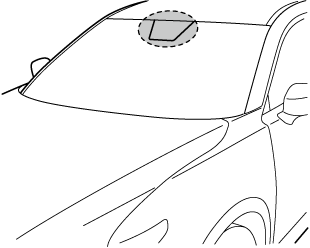
The Forward Sensing Camera (FSC) determines the conditions ahead of the vehicle while travelling at night and detects traffic lanes. The distance in which the Forward Sensing Camera (FSC) can detect objects varies depending on the surrounding conditions.
Do not modify the suspension:
If the vehicle height or inclination is changed, the system will not be able to correctly detect vehicles ahead. This will result in the system not operating normally or mistakenly operating, which could cause a serious accident.
-
Do not apply accessories, stickers or film to the windscreen near the Forward Sensing Camera (FSC).
If the area in front of the Forward Sensing Camera (FSC) lens is obstructed, it will cause the system to not operate correctly. Consequently, each system may not operate normally which could lead to an unexpected accident.
-
Do not disassemble or modify the Forward Sensing Camera (FSC).
Disassembly or modification of the Forward Sensing Camera (FSC) will cause a malfunction or mistaken operation. Consequently, each system may not operate normally which could lead to an unexpected accident.
-
Heed the following cautions to assure the correct operation of the Forward Sensing Camera (FSC).
-
Be careful not to scratch the Forward Sensing Camera (FSC) lens or allow it to get dirty.
-
Do not remove the Forward Sensing Camera (FSC) cover.
-
Do not place objects on the instrument panel which reflect light.
-
Always keep the windscreen glass around the camera clean by removing dirt or fogging. Use the windscreen defroster to remove fogging on the windscreen.
-
Consult an expert repairer, we recommend an Authorised Mazda Repairer regarding cleaning the interior side of the windscreen around the Forward Sensing Camera (FSC).
-
Consult an expert repairer, we recommend an Authorised Mazda Repairer before performing repairs around the Forward Sensing Camera (FSC).
-
The Forward Sensing Camera (FSC) is installed to the windscreen. Consult an expert repairer, we recommend an Authorised Mazda Repairer for windscreen repair and replacement.
-
When cleaning the windscreen, do not allow glass cleaners or similar cleaning fluids to get on the Forward Sensing Camera (FSC) lens. In addition, do not touch the Forward Sensing Camera (FSC) lens.
-
When performing repairs around the rearview mirror, consult an expert repairer, we recommend an Authorised Mazda Repairer.
-
Consult an expert repairer, we recommend an Authorised Mazda Repairer regarding cleaning of the camera lens.
-
Do not hit or apply strong force to the Forward Sensing Camera (FSC) or the area around it. If the Forward Sensing Camera (FSC) is severely hit or if there are cracks or damage caused by flying gravel or debris in the area around it, stop using the following systems and consult an expert repairer, we recommend an Authorised Mazda Repairer.
-
Adaptive LED Headlights (ALH)
-
Driver Attention Alert (DAA)
-
Lane-keep Assist System (LAS) & Lane Departure Warning System (LDWS)
-
Traffic Sign Recognition System (TSR)
-
Advanced Smart City Brake Support (Advanced SCBS)
-
Mazda Radar Cruise Control with Stop & Go function (MRCC with Stop & Go function)
-
Smart Brake Support (SBS)
-
-
The direction in which the Forward Sensing Camera (FSC) is pointed has been finely adjusted. Do not change the installation position of the Forward Sensing Camera (FSC) or remove it. Otherwise, it could result in damage or malfunction.
-
-
Always use tyres for all wheels that are of the specified size, and the same manufacturer, brand, and tread pattern. In addition, do not use tyres with significantly different wear patterns on the same vehicle as the system may not operate normally.
-
The Forward Sensing Camera (FSC) includes a function for detecting a soiled windscreen and informing the driver, however, depending on the conditions, it may not detect plastic shopping bags, ice or snow on the windscreen. In such cases, the system cannot accurately determine a vehicle ahead and may not be able to operate normally. Always drive carefully and pay attention to the road ahead.
-
In the following cases, the Forward Sensing Camera (FSC) cannot detect target objects correctly, and each system may be unable to operate normally.
-
The height of the vehicle ahead is low.
-
You drive your vehicle at the same speed as the vehicle ahead.
-
Headlights are not turned on during the night or when going through a tunnel.
-
-
In the following cases, the Forward Sensing Camera (FSC) may not be able to detect target objects correctly.
-
Under bad weather condition, such as rain, fog and snow.
-
The window washer is being used or the windscreen wipers are not used when it's raining.
-
Ice, fog, snow, frost, rainfall, dirt, or foreign matter such as a plastic bag is stuck on the windscreen.
-
Trucks with low loading platforms and vehicles with an extremely low or high profile.
-
When driving next to walls with no patterning (including fences and longitudinally striped walls).
-
The tail lights of the vehicle ahead are turned off.
-
A vehicle is outside the illumination range of the headlights.
-
The vehicle is making a sharp turn, or ascending or descending a steep slope.
-
Entering or exiting a tunnel.
-
Heavy luggage is loaded causing the vehicle to tilt.
-
Strong light is shone at the front of the vehicle (back light or high-beam light from on-coming vehicles).
-
There are many light emitters on the vehicle ahead.
-
When the vehicle ahead is not equipped with tail lights or the tail lights are turned off at nighttime.
-
Elongated luggage or cargo is loaded onto installed roof rails and covers the Forward Sensing Camera (FSC).
-
Exhaust gas from the vehicle in front, sand, snow, and water vapour rising from manholes and grating, and water splashed into the air.
-
When towing a malfunctioning vehicle.
-
The vehicle is driven with tyres having significantly different wear.
-
The vehicle is driven on down slopes or bumpy roads.
-
There are water puddles on the road.
-
The surroundings are dark such as during the night, early evening, or early morning, or in a tunnel or indoor parking lot.
-
The illumination brightness of the headlights is reduced or the headlight illumination is weakened due to dirt or a deviated optical axis.
-
The target object enters the blind spot of the Forward Sensing Camera (FSC).
-
A person or object bursts onto the road from the shoulder or cuts right in front of you.
-
You change lanes and approach a vehicle ahead.
-
When driving extremely close to the target object.
-
Tyre chains or a temporary spare tyre is installed.
-
The vehicle ahead has a special shape. For example, a vehicle towing a trailer house or a boat, or a vehicle carrier carrying a vehicle with its front pointed rearward.
-
-
If the Forward Sensing Camera (FSC) cannot operate normally due to backlight or fog, the system functions related to the Forward Sensing Camera (FSC) are temporarily stopped and the following warning lights turn on. However, this does not indicate a malfunction.
-
Adaptive LED Headlights (ALH) warning light (amber)
-
Lane-keep Assist System (LAS) & Lane Departure Warning System (LDWS) warning light
-
Mazda Radar Cruise Control with Stop & Go function (MRCC with Stop & Go function) warning indication
-
Smart Brake Support/Smart City Brake Support (SBS/SCBS) warning light (amber)
-
-
If the Forward Sensing Camera (FSC) cannot operate normally due to high temperatures, the system functions related to the Forward Sensing Camera (FSC) are temporarily stopped and the following warning lights turn on. However, this does not indicate a malfunction. Cool down the area around the Forward Sensing Camera (FSC) such as by turning on the air conditioner.
-
Adaptive LED Headlights (ALH) warning light (amber)
-
Lane-keep Assist System (LAS) & Lane Departure Warning System (LDWS) warning light
-
Mazda Radar Cruise Control with Stop & Go function (MRCC with Stop & Go function) warning indication
-
Smart Brake Support/Smart City Brake Support (SBS/SCBS) warning light (amber)
-
-
If the Forward Sensing Camera (FSC) detects that the windscreen is dirty or foggy, the system functions related to the Forward Sensing Camera (FSC) are temporarily stopped and the following warning lights turn on. However, this does not indicate a problem. Remove the dirt from the windscreen or press the defroster switch and defog the windscreen.
-
Adaptive LED Headlights (ALH) warning light (amber)
-
Lane-keep Assist System (LAS) & Lane Departure Warning System (LDWS) warning light
-
Mazda Radar Cruise Control with Stop & Go function (MRCC with Stop & Go function) warning indication
-
Smart Brake Support/Smart City Brake Support (SBS/SCBS) warning light (amber)
-
-
If there are recognizable cracks or damage caused by flying gravel or debris on the windscreen, always have the windscreen replaced. Consult an Authorised Mazda Repairer for replacement.
-
(With Advanced Smart City Brake Support (Advanced SCBS))
-
The Forward Sensing Camera (FSC) recognises pedestrians when all of the following conditions are met:
-
The height of a pedestrian is about 1 to 2 meters.
-
An outline such as the head, both shoulders, or the legs can be determined.
-
-
In the following cases, the Forward Sensing Camera (FSC) may not be able to detect target objects correctly:
-
Multiple pedestrians are walking, or there are groups of people.
-
A pedestrian is close to a separate object.
-
A pedestrian is crouching, lying, or slouching.
-
A pedestrian suddenly jumps into the road right in front of the vehicle.
-
A pedestrian opens an umbrella, or is carrying large baggage or articles.
-
A pedestrian is in a dark location such as during the night, or blends into the background by wearing clothes matching the background colour.
-
-
Radar Sensor (Front) (Some Models)
Your vehicle is equipped with a radar sensor (front).
The following systems also use the radar sensor (front).
-
Distance Recognition Support System (DRSS)
-
Mazda Radar Cruise Control with Stop & Go function (MRCC with Stop & Go function)
-
Smart Brake Support (SBS)
The radar sensor (front) functions by detecting the radio waves reflected off a vehicle ahead or an obstruction sent from the radar sensor.
The radar sensor (front) is mounted behind the front emblem.
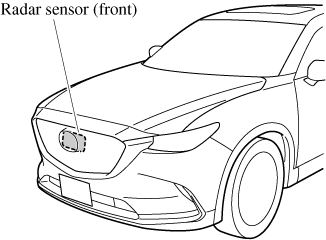
If “Front radar blocked” is displayed in the multi-information display of the instrument cluster, clean the area around the radar sensor (front).
Heed the following precautions to assure correct operation of each system.
-
Do not adhere stickers (including transparent stickers) to the surface of the radiator grille and front emblem in and around the radar sensor (front), and do not replace the radiator grille and front emblem with any product that is not a genuine product designed for use with the radar sensor (front).
-
The radar sensor (front) includes a function for detecting soiling of the radar sensor's front surface and informing the driver, however, depending on the conditions, it may require time to detect or it may not detect plastic shopping bags, ice or snow. If this occurs, the system may not operate correctly, therefore always keep the radar sensor (front) clean.
-
Do not install a grille guard.
-
If the front part of the vehicle has been damaged in a vehicle accident, the position of the radar sensor (front) may have moved. Stop the system immediately and always have the vehicle inspected at an Authorised Mazda Repairer.
-
Do not use the front bumper to push other vehicles or obstructions such as when pulling out of a parking space. Otherwise, the radar sensor (front) could be hit and its position deviated.
-
Do not remove, disassemble, or modify the radar sensor (front).
-
For repairs, replacement or paint work around the radar sensor (front), consult an Authorised Mazda Repairer.
-
Do not modify the suspension. If the suspension are modified, the vehicle's posture could change and the radar sensor (front) may not be able to correctly detect a vehicle ahead or an obstruction.
-
Under the following conditions, the radar sensor (front) may not be able to detect vehicles ahead or obstructions correctly and each system may not operate normally.
-
The rear surface of a vehicle ahead does not reflect radio waves effectively, such as an unloaded trailer or an automobile with a loading platform covered by a soft top, vehicles with a hard plastic tailgate, and round-shaped vehicles.
-
Vehicles ahead with low vehicle height and thus less area for reflecting radio waves.
-
Visibility is reduced due to a vehicle ahead casting off water, snow, or sand from its tyres and onto your windscreen.
-
The luggage compartment is loaded with heavy objects or the rear passenger seats are occupied.
-
Ice, snow, or soiling is on the front surface of the front emblem.
-
During inclement weather such as rain, snow, or sand storms.
-
When driving near facilities or objects emitting strong radio waves.
-
-
Under the following conditions, the radar sensor (front) may not be able to detect vehicles ahead or obstructions.
-
The beginning and end of a curve.
-
Roads with continuous curves.
-
Narrow lane roads due to road construction or lane closures.
-
The vehicle ahead enters the radar sensor's blind spot.
-
The vehicle ahead is running abnormally due to accident or vehicle damage.
-
Roads with repeated up and down slopes
-
Driving on poor roads or unpaved roads.
-
The distance between your vehicle and the vehicle ahead is extremely short.
-
A vehicle suddenly comes close such as by cutting into the lane.
-
-
To prevent incorrect operation of the system, use tyres of the same specified size, manufacturer, brand, and tread pattern on all four wheels. In addition, do not use tyres with significantly different wear patterns or tyre pressures on the same vehicle (Including the temporary spare tyre).
-
If the battery power is weak, the system may not operate correctly.
-
When driving on roads with little traffic and few vehicles ahead or obstructions for the radar sensor (front) to detect, “Front radar blocked” may be temporarily displayed, however, this does not indicate a problem.
Radar Sensors (Rear) (Some Models)
Your vehicle is equipped with radar sensors (rear). The following systems also use the radar sensors (rear).
-
Blind Spot Monitoring (BSM)
-
Rear Cross Traffic Alert (RCTA)
The radar sensors (rear) function by detecting the radio waves reflected off a vehicle approaching from the rear or an obstruction sent from the radar sensor.
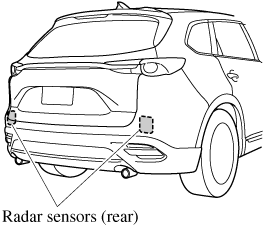
The radar sensors (rear) are installed inside the rear bumper, one each on the left and right sides.
Always keep the surface of the rear bumper near the radar sensors (rear) clean so that the radar sensors (rear) operate normally. Also, do not apply items such as stickers.
Refer to Exterior Care (Search).
If the rear bumper receives a severe impact, the system may no longer operate normally. Stop the system immediately and have the vehicle inspected at an expert repairer, we recommend an Authorised Mazda Repairer.
-
The detection ability of the radar sensors (rear) has limitations. In the following cases, the detection ability may lower and the system may not operate normally.
-
The rear bumper near the radar sensors (rear) has become deformed.
-
Snow, ice or mud adheres to the radar sensors (rear) on the rear bumper.
-
Under bad weather conditions such as rain, snow and fog.
-
-
Under the following conditions, the radar sensors (rear) cannot detect target objects or it may be difficult to detect them.
-
Stationary objects on a road or a road side such as small, two-wheeled vehicles, bicycles, pedestrians, animals, and shopping carts.
-
Vehicle shapes which do not reflect radar waves well such as empty trailers with a low vehicle height and sports cars.
-
-
Vehicles are shipped with the direction of the radar sensors (rear) adjusted for each vehicle to a loaded vehicle condition so that the radar sensors (rear) detect approaching vehicles correctly. If the direction of the radar sensors (rear) has deviated for some reason, have the vehicle inspected at an expert repairer, we recommend an Authorised Mazda Repairer.
-
For repairs or replacement of the radar sensors (rear), or bumper repairs, paintwork, and replacement near the radar sensors, consult an expert repairer, we recommend an Authorised Mazda Repairer.
-
Turn off the system while pulling a trailer or while an accessory such as a bicycle carrier is installed to the rear of the vehicle. Otherwise, the radio waves emitted by the radar will be blocked causing the system to not operate normally.
-
The radar sensors are regulated by the relevant radio wave laws of the country in which the vehicle is driven. If the vehicle is driven abroad, authorization from the country in which the vehicle is driven may be required.
Ultrasonic Sensor (Rear) (Some Models)
The ultrasonic sensors (rear) function by emitting ultrasonic waves which are reflected off obstructions at the rear and the returning ultrasonic waves are picked up by the ultrasonic sensors (rear).
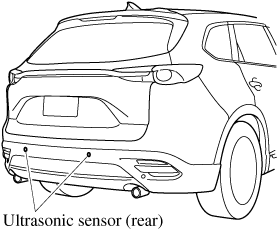
The ultrasonic sensors (rear) are mounted in the rear bumper.




















































